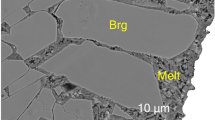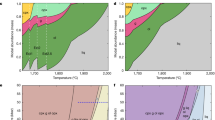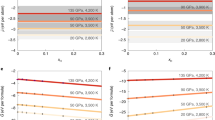Abstract
Calculations of the sthermal evolution of the Earth during accretion suggest that the outer layer may once have been molten, perhaps to a depth of 1,000 km or more1,2. If such global melting did occur, fractionation processes could have produced a chemical stratification in the mantle. Recent technical developments in experimental petrology have made it possible to achieve temperatures in excess of 2,000°C at a pressure of 20 GPa3,4, thereby permitting studies of multi-component systems under conditions that prevail in the Earth's mantle. We have conducted melting experiments using a composition in the five-component system CaO–FeO–MgO–Al2O3–SiO2 (CFMAS) corresponding to a model chondritic mantle, and find that the liquidus phase changes from olivine to majorite at a pressure between 12 and 15 GPa. The liquid coexisting with majorite at 20 GPa has a peridotitic composition. In addition, because the CaO/A12O3 ratio of the liquidus majorite at 20 GPa is lower than that of the sub-solidus majorite, partial melting and majorite fractionation at the base of the upper mantle could produce a peridotitic liquid with a CaO/A12O3 ratio greater than that of the chondritic starting material, consistent with current views on mantle geochemistry.
This is a preview of subscription content, access via your institution
Access options
Subscribe to this journal
Receive 51 print issues and online access
$199.00 per year
only $3.90 per issue
Buy this article
- Purchase on Springer Link
- Instant access to full article PDF
Prices may be subject to local taxes which are calculated during checkout
Similar content being viewed by others
References
Kaula, W. H. J. geophys. Res. 84, 999–1008 (1979).
Hayashi, C., Nakazawa, K. & Mizuno, H. Earth planet. Sci. Lett. 43, 22–28 (1979).
Ohtani, E. & Kumazawa, M. Phys. Earth planet. Inter. 27, 32–38 (1981).
Kato, T. & Kumazawa, M. Phys. Earth planet. Inter. 41, 1–5 (1985).
Ganapathy, R. & Anders, E. Geochim. cosmochim. Ada Suppl. 5, 1181–1209 (1974).
Anderson, D. L. J. geophys. Res. 88, B41–B52 (1983).
Liu, L. G. Geochem. J. 16, 287–310 (1982).
Anders, E. & Ebihara, M. Geochim. cosmochim. Acta 46, 2363–2380 (1982).
Akimoto, S., Yagi, T. & Inoue, K. in High-Pressure Research: Applications in Geophysics (eds Manghnani, M. H. & Akimoto, S.) 595–602 (Academic, New York, 1977).
Takahashi, E. & Scarfe, C. M. Nature 315, 566–568 (1985).
Irifune, T. & Hibberson, W. O. High Temp. high Press. 17, 575–579 (1985).
Herzberg, C. T. & O'Hara, P. J. Geophys. Res. Lett. 12, 541–544 (1985).
Walker, D. & Herzberg, C. T. Eos 66, 403–404 (1985).
Ohtani, E. Phys. Earth planet. Inter. 38, 70–80 (1985).
Pulme, H. & Nickel, K. G. Geochim. cosmochim. Acta 49, 2123–2132 (1985).
Author information
Authors and Affiliations
Rights and permissions
About this article
Cite this article
Ohtani, E., Kato, T. & Sawamoto, H. Melting of a model chondritic mantle to 20 GPa. Nature 322, 352–353 (1986). https://doi.org/10.1038/322352a0
Received:
Accepted:
Issue Date:
DOI: https://doi.org/10.1038/322352a0
This article is cited by
-
A new look at differentiation of the Earth from melting experiments on the Allende meteorite
Nature (1990)
-
Aluminum partitioning between olivine and ultrabasic silicate liquid to 6 GPa
Contributions to Mineralogy and Petrology (1990)
-
Partitioning of elements between majorite garnet and melt and implications for petrogenesis of komatiite
Contributions to Mineralogy and Petrology (1989)
-
Majorite fractionation recorded in the geochemistry of peridotites from South Africa
Nature (1988)
Comments
By submitting a comment you agree to abide by our Terms and Community Guidelines. If you find something abusive or that does not comply with our terms or guidelines please flag it as inappropriate.



